Physical Address
304 North Cardinal St.
Dorchester Center, MA 02124
Fractures of the distal humerus commonly occur in osteoporotic bone, accompanied by comminution in the metaphyseal and/or articular regions. Consequently, the surgical management of these injuries may be technically demanding. This chapter provides a review of these issues and others, as well as an up-to-date appraisal on the available evidence to guide management.
Distal humerus fractures have been estimated to have an incidence in adults of 5.7 per 100,000 persons per year. They occur in a bimodal distribution: One peak occurs in young males (12 to 19 years of age) who sustain this injury after high-energy trauma, and one peak occurs consequent to low-energy trauma in older patients with poor bone quality. Finnish National Health Registry data demonstrate that the incidence of these fractures is highly variable, ranging from 12 to 34 fractures per 100,000 persons. The same authors observed increases in the incidence of fractures from 1970 to 1998 but decreases from 1998 to 2014. They speculate that this decreasing incidence may result from improvements in fall prevention.
The ulnohumeral joint can be characterized as a hinge joint in that it has only a single axis of rotation where the ulna rotates with respect to the humerus around a transverse axis. The semilunar notch of the proximal ulna articulates around the trochlea of the distal end of the humerus ( Fig. 45.1 ).
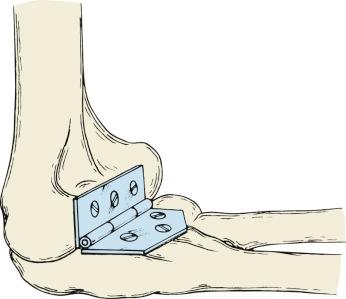
The term trochlea is derived from the Greek word for pulley, although to the modern eye it appears more like a spool. Conceptually, the trochlea is supported between two bony columns, much like the ends of a spool of thread that are held between the thumb and index finger ( Fig. 45.2 ). The end of the skeleton of the humerus splits in a wishbone fashion to form the two columns that support the trochlea. By interconnecting with these divergent columns, the terminal part of the elbow joint most resembles a triangle. Disruption of this triangle results in loss of mechanical stability. It is important to stabilize the elements of this triangle when planning internal fixation.
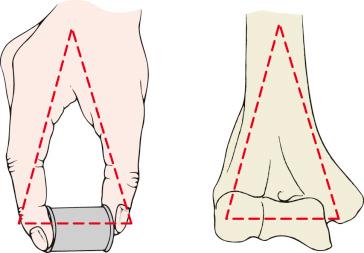
A second articulation is the radiocapitellar joint. There are reasons to consider the capitellum and its articulation with the radius as a joint separate from the elbow (i.e., the ulnotrochlear joint). Mechanically, the radiocapitellar joint contributes to the function of forearm rotation and is generally independent of elbow flexion and extension. In short, it is possible to have an arthrodesis of the elbow joint and yet have full forearm rotation if there are no disorders of the forearm axis. However, if the radiocapitellar joint is malaligned, this can block forearm rotation.
On viewing the distal end of the humerus from a posterior aspect, the trochlea and its articular surface are readily appreciated to be centrally located between the lateral and the medial distal humeral columns from which the trochlea is suspended. Conversely, the capitellum is not seen, and only on viewing the distal portion of the humerus from the anterior surface does it become apparent that the capitellum represents the cartilage-covered anterior surface of the end of the lateral column. It may well be best to view it as such rather than as an integral articular part of the distal end of the humerus and elbow joint. It can be removed from the distal part of the humerus traumatically or surgically and not interfere with the structural integrity of the “distal humeral triangle.” However, malunion of a capitellar fragment proximally can inhibit flexion of the elbow because the radial head impinges at the site of the obliterated radial fossa, and because the radius and ulna are closely linked, the restriction of the movement of one bone does have an indirect effect on the other.
Although the ulnotrochlear joint behaves as a hinge joint with a single axis of rotation, the motion of the elbow appears to be more complex clinically. The trochlear axis with respect to the longitudinal axis of the humerus is approximately 94 degrees in valgus in males and 98 degrees in females ( Fig. 45.3 ). In addition, the trochlear axis is externally rotated between 3 and 8 degrees with respect to a line connecting the medial and lateral epicondyles. This orientation, therefore, places the forearm in a slight degree of external rotation when the elbow is in 90 degrees of flexion.
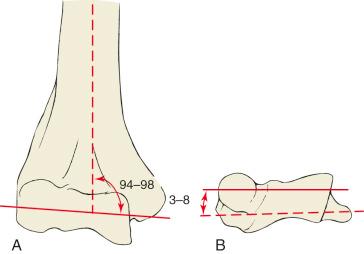
This normal valgus position of the elbow is commonly referred to as the carrying angle of the elbow. Functionally, the combination of external rotation and valgus allows the positioning of objects away from the body when they are held with the elbow in extension.
When viewed from a posterior approach, the triceps muscle can be appreciated attaching to the olecranon. The insertion of the triceps is broad and inserts over a large portion of the base of the olecranon. A portion of the triceps fascia is confluent with the anconeus fascia and extends laterally over the distal elbow. Medially, the ulnar nerve lies deep to the posterior brachial fascia but lies superficial to the medial intermuscular septum. The ulnar nerve passes through the cubital tunnel, the roof of which is a thick fibrous structure called Osborne's ligament. The ulnar nerve then passes deep into the flexor-pronator mass, where there is a superficial and deep fascia overlying the nerve.
When the triceps is elevated, the division of the humeral shaft into medial and lateral columns can be appreciated. The medial column ends approximately 1 cm proximal to the distal end of the trochlea, whereas the lateral column extends to the distal aspect of the trochlea ( Fig. 45.4 ), where its cartilage-covered anterior surface forms the capitellum.
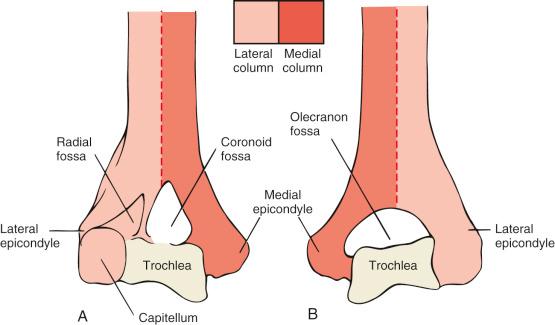
Bounded by the triangular structure of the distal end of the humerus is a depression—the olecranon fossa. This fossa accommodates the proximal tip of the olecranon when the elbow is fully extended. The intramedullary canal of the humerus tapers to an end 2 to 3 cm proximal to the olecranon fossa, and the humerus becomes very thin distally between the medial and the lateral columns. Up to 6% of patients may have an actual bony defect in this area termed a septal aperture (a normal anatomic variant). The posterior capsule originates at the boundaries of the olecranon fossae and then proceed distally to the olecranon and radius. A layer of fatty tissue, the posterior fat pad, is normally contained within the olecranon fossa. This fat pad is sandwiched between two layers of the posterior joint capsule (i.e., the fibrous layer, which is superficial to the fat pad, and the synovial layer, which is deep). In the presence of an intraarticular effusion, the fat pad is displaced posteriorly and becomes visible on a lateral radiograph as the so-called posterior fat-pad sign. After trauma or surgery, the posterior fat pad can become fibrotic or adherent to the olecranon fossa and contribute to the extension deficits that are commonly observed after major trauma to the elbow.
The medial and lateral columns are not as apparent from an anterior perspective, primarily because of the lack of a counterpart to the deep olecranon fossa to put the columns in relief. However, a small coronoid fossa is located just proximal to the trochlea and an even smaller radial fossa just proximal to the capitellum. These two fossae are separated by a longitudinal ridge of bone that continues distally with the lateral lip of the trochlea. This longitudinal ridge and the lateral trochlear lip form the anatomic division between the lateral and the medial columns. The coronoid fossa and trochlea are situated between the two columns and form a symmetrical intercolumnar arch (see Fig. 45.4 ). The medial column begins at the medial border of this arch.
The medial column of the distal end of the humerus diverges from the humeral shaft at an approximately 45-degree angle. The proximal two-thirds of this column is cortical bone. The distal third of the column represents the medial epicondyle, which is composed of cancellous bone and is ovoid in cross section. The medial and superior surfaces of the medial epicondyle serve as the origins of the flexor muscle mass of the forearm. The inferior medial epicondyle additionally serves as the origin for the anterior and posterior bundles of the ulnar (medial) collateral ligament ( Fig. 45.5 ). Accurate reduction and fixation of a medial epicondylar fracture fragment are critical to the restoration of elbow stability.

It is of surgical importance to recognize that the inferior surface of the medial epicondyle is available for the placement of internal fixation, as long as the origin of the MCL is preserved on the most medial portion of the medial epicondyle. The ulnar nerve, which runs in the cubital tunnel below this structure, can be mobilized and transposed anteriorly, and the entire posterior medial column can be used for the placement of internal fixation. Because no articulations are present on the anterior aspect of the medial column, screws can penetrate anteriorly and not interfere with articular function. The triangular shape of this medial column should be kept in mind because it affords excellent purchase for screws. The screws should be directed somewhat medially to obtain purchase on the anteromedial cortex, which is more substantial.
The lateral column of the distal end of the humerus diverges from the humeral shaft at the same level as the medial column but forms approximately a 20-degree angle with the axis of the humeral shaft. The proximal half of this column has thick cortical bone, with the posterior aspect being broad and flat and ideal for plate placement. The distal half of the lateral column has a thinner cortex. From the posterior view, this part of the lateral column begins at the level of the middle of the olecranon fossa. As it extends distally, it begins to gradually curve anteriorly. The anconeus muscle covers the lateral column as it follows the curvature of the adjacent trochlea. At the most distal point of this curve, the capitellar cartilage begins. It represents the distal limit that would allow internal fixation posteriorly, and transgression of this point with fixation can result in impingement of the radial head. The concept of the columnar structure of the distal end of the humerus is important when considering where to place internal fixation because the anterior aspect of the lateral column cannot be seen directly from the posterior view. One must bear in mind that the trochlea lies between the two columns, whereas the capitellum is part of the lateral column. It therefore follows that the olecranon and coronoid fossae associated with the trochlea are intercolumnar, whereas the radial fossa associated with the capitellum is part of the lateral column. The radial fossa is vulnerable to screw penetration when applying internal fixation to the posterior aspect of the lateral column.
When viewed from the anterior surface, a rough ridge of bone is seen projecting laterally farther along the lateral column from its proximal tubular portion. This bone is the lateral supracondylar ridge. The brachioradialis and extensor carpi radialis longus muscles originate from this ridge, which ultimately blends distally with the lateral epicondyle. The lateral epicondyle, although smaller than its counterpart on the medial side, is the point of origin of the lateral collateral ligament (LCL) of the elbow. This ligament is not as distinct as its medial counterpart but is part of a lateral ligamentous complex that blends with the common extensor origin and the annular ligament. The anterior fibers of the LCL insert on the supinator crest of the proximal end of the ulna. The LCL complex is the primary constraint against posterolateral instability of the elbow; accurate reduction of this fragment helps prevent ulnohumeral instability. The common extensor muscle origin arises from the lateral tip of the epicondyle posterior to the radial portion of the LCL (see Fig. 45.5 ).
Medially and anteriorly, the lateral column is bounded by the longitudinal ridge. Proceeding distally, the column indents to form the shallow radial fossa. Just below this fossa, the capitellum juts out anteriorly as a hyaline cartilage-covered, incomplete hemisphere. The midpoint of this hemisphere is directly anterior and is an arc of only 180 degrees in the sagittal plane. This arc must be compared with an articular arc of 270 degrees for the trochlea. The rotational center of the capitellum is displaced between 12 and 15 mm in front of the humeral shaft axis and is aligned with the trochlear axis. Thus the ulna and radius flex and extend coaxially.
The trochlea is the intercolumnar “tie rod.” It has the form of a spool and is composed of medial and lateral lips with an intervening sulcus. The sulcus articulates with the semilunar notch of the proximal end of the ulna, and the adjacent lips offer medial and lateral stability to this simple articulation. The anterior and distal aspects of the lateral trochlear lip have a different radius of curvature than the medial lip, thus changing the symmetry of the trochlea. This asymmetry gives the impression that the trochlea is mechanically complex. Although many have thought that this asymmetrical shape positions the ulna in a different axis from flexion to extension, London has shown that it is part of a pure and simple hinge joint. However, as the elbow moves through its flexion-extension arc, normal kinematics allow for 3 to 4 degrees of varus or valgus laxity in response to applied force. Thus the elbow does not function as a tightly constrained joint but has a mild degree of varus–valgus laxity, which has been described as a “sloppy hinge” that some elbow arthroplasty designs emulate.
Avascular necrosis is uncommon in distal humeral fractures. However, preservation of the blood supply can be important for a variety of clinical reasons, especially fracture healing. A cadaver study by Yamaguchi and colleagues involving an India ink/latex injection technique showed that the blood supply of the distal part of the humerus follows a consistent pattern in both the intraosseous and extraosseous circulation ( Fig. 45.6 ). The blood supply of the elbow can be conceptualized into three arcades: medial, lateral, and posterior. The medial arcade is formed by the superior and inferior ulnar collateral arteries and the posterior ulnar recurrent artery. The lateral arcade is formed by the radial and middle collateral, radial recurrent, and interosseous recurrent arteries, whereas the posterior arcade is derived primarily from the medial and lateral arcades. The intraosseous circulation is derived mainly from perforating vessels from these arcades, thus suggesting that careful preservation of these vessels may enhance the blood supply and, by logical extension, fracture healing. The importance of preserving such vessels is especially true for the “watershed areas” (e.g., the trochlear groove) that were identified as having sparse circulation.
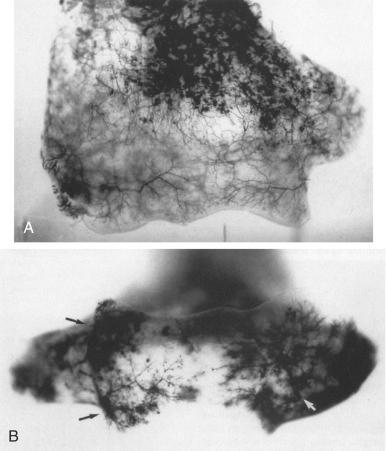
The clinical evaluation of a patient with a distal humerus fracture begins with a precise history that includes hand dominance; profession; date and detailed mechanism of injury; associated symptoms; review of other potential areas of injury; and a pertinent medical, surgical, and social history. The physical examination consists of an assessment of the ipsilateral shoulder and wrist, examination of the skin for open wounds and fracture blisters, and a detailed neurovascular examination. The elbow region itself is examined for swelling, ecchymosis, and areas of tenderness. Range-of-motion (ROM) assessment of the elbow and examination for ligamentous stability are typically precluded by pain. Open distal humerus fractures most commonly have a posterior or posterolateral wound proximal to the elbow joint that is created by protrusion of the humeral shaft through the triceps muscle and posterior skin. The vascular evaluation includes palpation of radial and ulnar pulses, assessment of capillary refill (which should be less than 3 seconds), and examination of the hand for appropriate warmth and color. Neurologic assessment should include an examination of the median, radial, and ulnar nerves. The prevalence of preoperative ulnar nerve symptoms in patients with type C fractures of the distal humerus has been reported to be approximately 25%.
After clinical assessment, anterior-posterior (AP) and lateral radiographs of the distal humerus should be obtained. These radiographs should be carefully screened for fracture pattern, displacement, and articular involvement. Traction radiographs can be useful, but this technique has largely been supplanted by computed tomography (CT) scanning, which can be very helpful in the presence of articular comminution, coronal fracture patterns, and associated fractures of the radial head or proximal ulna. In addition, the use of CT scanning with three-dimensional (3-D) reconstructions can be helpful for classification and preoperative planning. A study by Doornberg and colleagues compared the use of 3-D CT reconstructions to the use of two-dimensional (2-D) CT and plain radiographs for the classification of distal humerus fractures and treatment decision making. The authors reported increased interobserver and intraobserver reliability for fracture classification with the use of 3-D CT, as well as increased intraobserver agreement for treatment decisions. Numerous level IV case series have reported on the use of CT, primarily for the evaluation of coronal fractures of the distal humerus. We routinely evaluate fractures of the distal humerus with preoperative CT scanning if radiographs indicate articular involvement or coronal fractures.
Distal humerus fractures involve the supracondylar region of the humerus and/or the articular surface of the distal humerus. Although many classification systems have been described, they are most commonly classified according to the Orthopaedic Trauma Association/Arbeitsgemeinschaft für Osteosynthesefragen (OTA/AO) classification system ( Fig. 45.7 ). In this classification system “A” designates an extraarticular fracture, “B” designates a partial articular fracture, and “C” indicates an intraarticular fracture in which the articular surface is completely dissociated from the shaft of the humerus. Based on epidemiologic data from the United Kingdom, a distribution of 38.7% type A fractures, 24.1% type B fractures, and 37.2% type C fractures has been reported.
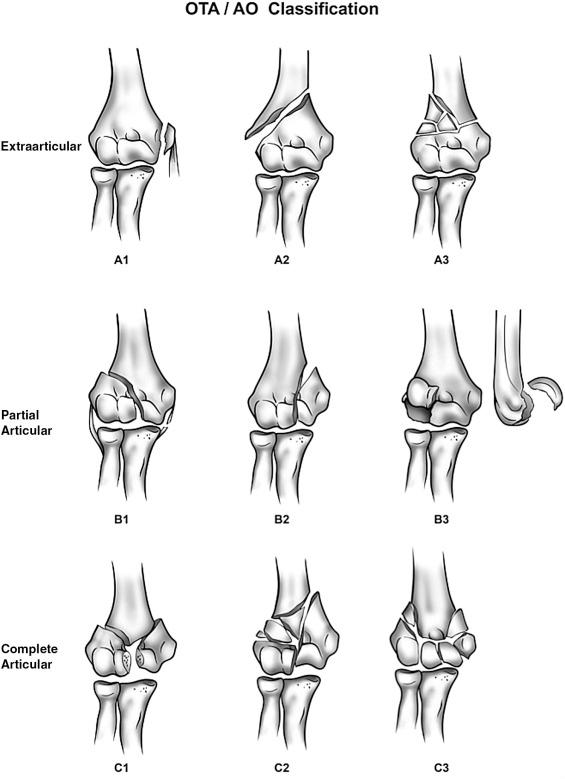
These three types are further subdivided using the numbers 1 to 3 to indicate increasing degrees of comminution or further define the location of the fracture. A1 fractures represent avulsion of either of the epicondyles. A2 and A3 fractures are complete fractures of the supracondylar region with no extension to the articular surface and with the A3 subtype reflecting comminution in the metaphyseal region. B1 and B2 fractures represent partial articular fractures of the lateral and medial columns, respectively. B3 fractures are partial articular fractures of the distal humerus with a fracture line that is primarily coronally oriented and are commonly referred to as “coronal fractures.” These fractures represent a unique subtype of distal humerus fractures that have been further classified by Bryan and Morrey, with later modification of the classification system by McKee and coworkers. Type I represents a coronal fracture of the capitellum (Hahn–Steinthal), a type II is an osteochondral lesion of the capitellum (Kocher–Lorenz), a type III is a comminuted fracture of the capitellum, and type IV represents a fracture of the capitellum with medial extension encompassing part or all of the trochlea. Dubberly et al. have proposed an alternative classification system with three types: (1) isolated capitellar fracture, (2) a coronal fracture including both the capitellum and the trochlea as a single fragment, and (3) a coronal fracture of the capitellum and a separate coronal fracture of the trochlea.
C1 fractures involve the entire articular surface, but comminution is absent, and two primary fracture lines exist: a transverse fracture line in the supracondylar region and a vertical fracture line extending into the articular surface. In the past, these fractures have been described as T- or Y-type fractures. C2 fractures have a similar pattern to C1 fractures but with comminution of the metaphyseal region and a simple intraarticular split. C3 fractures have comminution of both the metaphyseal region and articular surface. It is important to recognize that C3 type fractures can often have an associated coronal component (a coronally oriented fracture line involving the capitellum and/or trochlea) that is best identified with CT scanning because this may influence both the choice of surgical approach and the ideal fixation strategy ( Fig. 45.8 ).
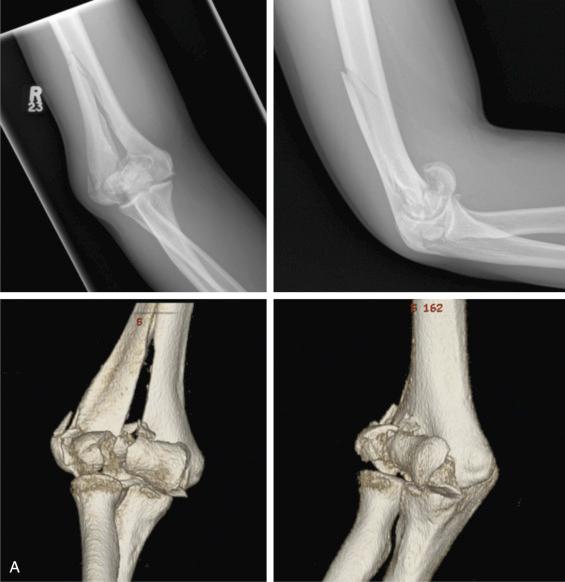
A- and C-type fractures are discussed together because their management (including surgical approach and fixation strategies) is generally similar and is based on common principles. B-type fractures are discussed separately, with a particular emphasis on coronal fractures (B3) because this unique subtype of fracture often requires a different surgical approach and fixation strategy.
The initial management of a distal humerus fracture should involve gentle realignment of the limb and application of a well-padded splint. Open fractures should be managed with local wound care and early antibiotic and tetanus administration. Suspected vascular injuries should be investigated emergently, and urgent consultation should be obtained from hand surgery or vascular surgery. Neurologic injuries should be carefully documented and monitored. After application of the splint, further imaging of the fracture can be performed with CT.
The modern outcomes of operative fixation of distal humerus fractures in adults are such that operative intervention is indicated in most cases. Nonoperative management is reserved for completely undisplaced fractures, patients who are unable to tolerate an anesthetic, or those patients who may not benefit from the advantages of fixation (i.e., advanced dementia). In medically unwell patients, nonoperative treatment can produce modest outcomes. But the currently available evidence suggests that operative management of distal humerus fractures is favored over nonoperative management with regard to several important outcomes. Two level III studies, including one that was based exclusively on patients aged 75 years or older, compared functional outcomes for operatively and nonoperatively treated patients ( n = 70 patients). A pooled analysis of the patients from those two studies reveals that patients treated without surgery are almost three times more likely to have an unacceptable result (relative risk, 2.8; 95% confidence interval, 1.78 to 4.4). Another retrospective study, by Robinson and colleagues, compared the results in 273 operatively treated patients to 47 nonoperatively treated patients (level III evidence). They reported in their series that nonoperatively treated patients were almost six times more likely to have a nonunion (relative risk, 5.8; 95% confidence interval, 2.3 to 14.7) and four times more likely to have delayed union (relative risk, 4.4; 95% confidence interval, 1.6 to 12.0). Numerous recent level IV studies, reporting on modern techniques of fixation for distal humerus fractures, have reported high rates of satisfactory outcomes (47% to 93%), with an acceptable rate of complications (19% to 53%). In patients deemed either too high risk for administration of an anesthetic or unlikely to benefit from surgery due to low functional status, conservative treatment with the “bag-of-bones” technique is appropriate. This typically involves immobilization of the elbow in 60 to 70 degrees of flexion for 2 to 3 weeks, followed by gentle ROM.
Become a Clinical Tree membership for Full access and enjoy Unlimited articles
If you are a member. Log in here